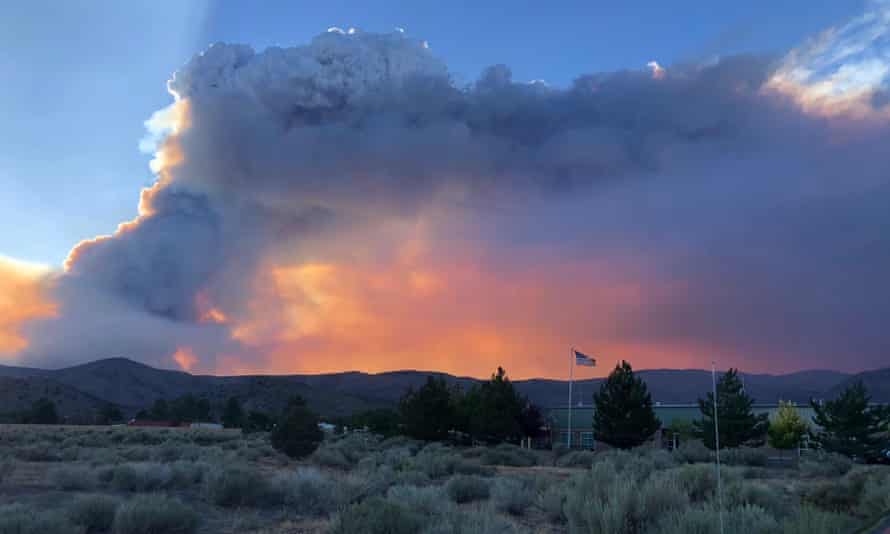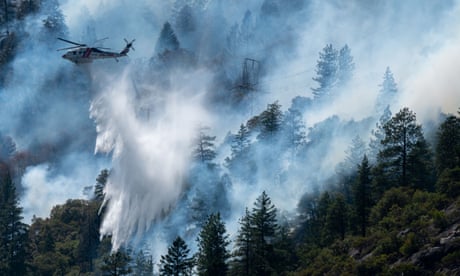Extract from The Guardian
Tamarack fire spreads from California to Nevada while weather aids firefighters in Oregon.

The east side of the Tamarack fire, which has crossed the California state line into Nevada.
Last modified on Fri 23 Jul 2021 05.47 AEST
A northern California wildfire crossed into Nevada, prompting new evacuations, but better weather has been helping crews battling the nation’s largest blaze in southern Oregon.
Meanwhile, the major California utility provider PG&E has announced a multibillion-dollar effort to bury 10,000 miles (16,000km) of its power lines, after its electrical equipment was once again blamed for igniting a separate, fast-growing fire in the state’s north-east.
There are dozens of fires burning across the American west. The Tamarack fire, which crossed into Nevada, is burning south of Lake Tahoe and had burned more than 68 sq miles (176 sq km) of timber and head-high chaparral in national forest land as of Thursday. It erupted on 4 July and was one of nearly two dozen blazes sparked by lightning strikes.
Morgana-Le-Fae Veatch, an evacuee, said she already had boxed up most of her belongings because she is starting community college next week but her parents lost their house in a 1987 blaze.
“So this has been really, really stressing to them,” she said.
To the north-west, the summer fun of boating and bathing came to an abrupt end for vacationers at Lake Almanor as the Dixie fire spread up the west flank of the Sierra Nevada, expanding to more than 162 square miles. The west shore of the resort lake and many other small communities were under evacuation orders.
Pacific Gas & Electric, the state’s largest utility provider, recently informed state regulators that the Dixie fire was sparked after a 70ft (23-meter) pine tree toppled on one of its power lines. The state’s largest electricity company has long faced criticism over its equipment’s role in sparking devastating blazes, including the 2018 Camp fire that killed more than 80 people and destroyed thousands of homes in and around the town of Paradise.

The daunting project of burying power lines, announced on Wednesday, aims to bury about 10% of PG&E’s distribution and transmission lines at a projected cost of $15bn to $30bn, based on how much the process currently costs. Previous PG&E regimes have staunchly resisted plans to bury long stretches of power lines because of the expense involved.
But the company’s recently hired CEO, Patricia “Patti” Poppe, said on Wednesday that she had quickly realized after she joined PG&E in January that moving lines underground was the best way to protect both the utility and the 16 million people who rely on it for power.
“It’s too expensive not to do it. Lives are on the line,” Poppe told reporters. PG&E said only that burying the lines would take several years.
Meanwhile, Oregon on Wednesday banned all campfires on state-managed lands and in state campgrounds east of Interstate 5, the major highway that is commonly considered the dividing line between the wet western part of the state and the dry eastern half.
The country’s largest wildfire, Oregon’s Bootleg fire, grew to 624 sq miles – just over half the size of Rhode Island.
However, authorities said lower winds and temperatures allowed crews to improve fire lines. The fire also was approaching an area burned by a previous fire on its active south-eastern flank, raising hopes that lack of fuel could reduce its spread.
The Oregon fire, which was sparked by lightning, has ravaged the sparsely populated southern part of the state and had been expanding by up to four miles a day, pushed by strong winds and critically dry weather that turned trees and undergrowth into a tinderbox.
Fire crews have had to retreat from the flames for 10 consecutive days as fireballs jump from treetop to treetop, trees explode, embers fly ahead of the fire to start new blazes and, in some cases, the inferno’s heat creates its own weather of shifting winds and dry lightning. Monstrous clouds of smoke and ash have risen up to six miles into the sky and are visible for more than 100 miles.
The blaze, which is being fought by more than 2,200 people, is more than one-third contained.
At least 2,000 homes were ordered evacuated at some point during the fire and an additional 5,000 were threatened. At least 70 homes and more than 100 outbuildings have burned, but no one is known to have died.
Extremely dry conditions and recent heatwaves tied to the climate crisis have made wildfires harder to fight. Climate change has made the west much warmer and drier in the past 30 years and will continue to make weather more extreme and wildfires more frequent and destructive.
No comments:
Post a Comment